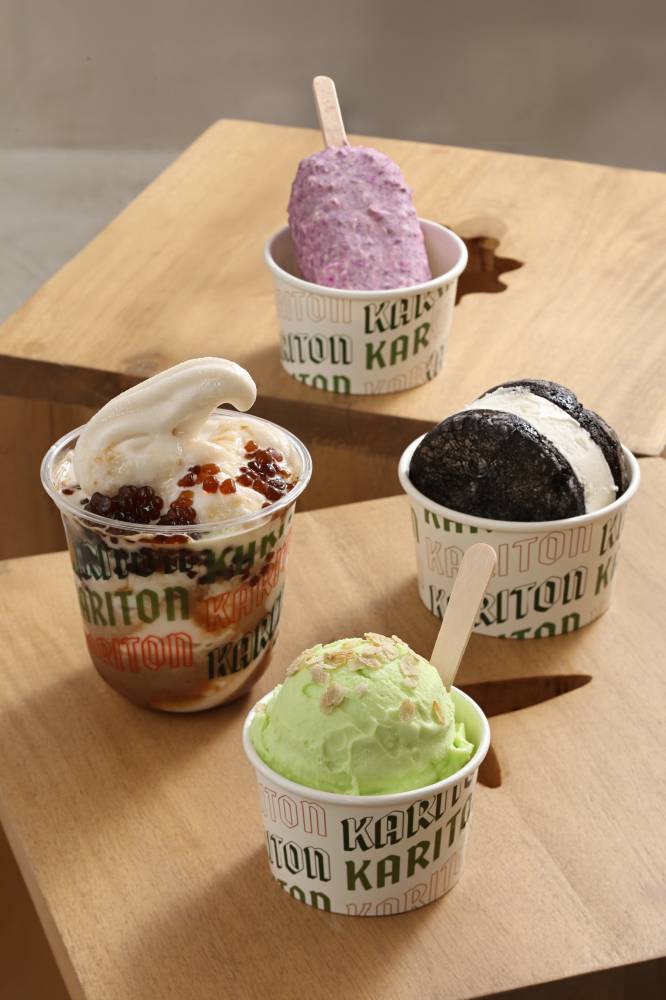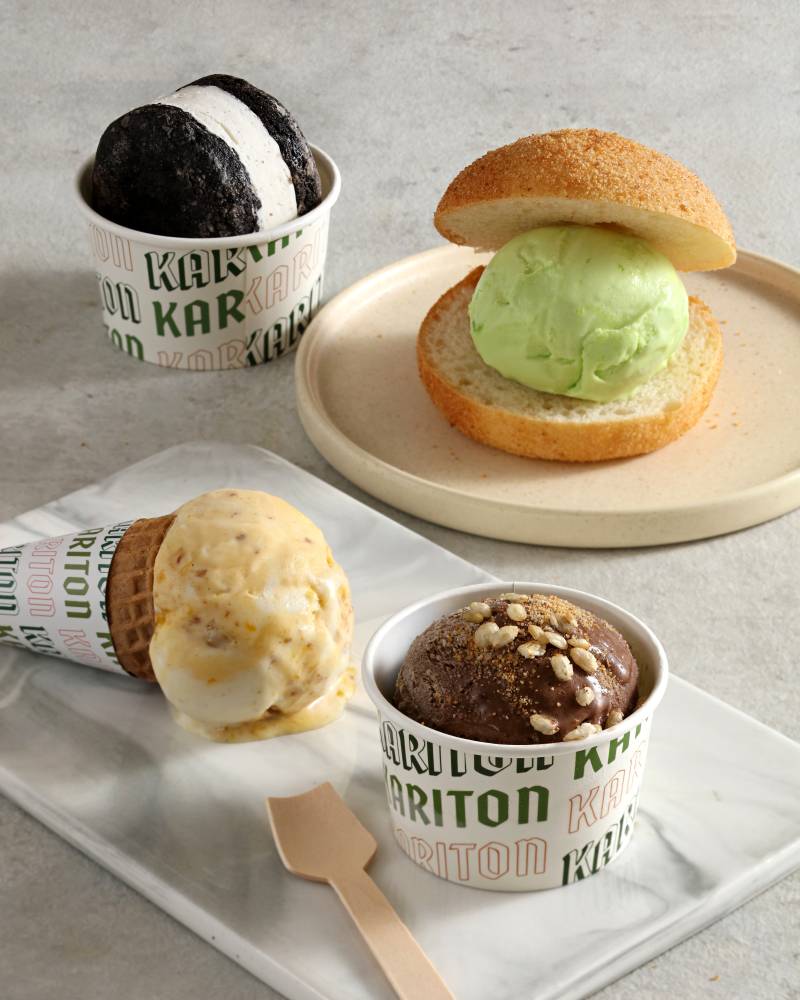Have you had champorado gelato or taho soft serve?

One of the biggest scoops in F&B last year was the imminent arrival of Melbourne gelato shop Kariton in Manila. Now in 2025, Kariton has finally set up shop at the foodie mecca of Molito Lifestyle Center in Alabang, their first brick and mortar in what can be described as an aggressive Philippine expansion plan.
What’s more, in the next two months, a pop-up in SM Aura will roll out, before branches in Salcedo Village and BGC—each with its own distinct identity that adapts to the environment—will begin to unveil themselves in the first quarter of 2026.
The story behind the scoop
While Kariton’s Philippine roadmap looks swift, it took a few years before it eventually made inroads locally. Entrepreneur and FEATR Media’s Erwan Heussaff, who is the brand’s local partner, first encountered Kariton’s gelatos back in 2020 at the height of the Melbourne lockdowns.
“I just happened to be in Melbourne because my wife gave birth there in 2020, so we were stuck there as well,” he says. “And [Kariton co-founder] John [Rivera] hand-carried the very first tub of ube halaya to our house, and that’s when I tried it. That’s when I started kind of talking to the guys.”
Given Heussaff’s proven track record, not just in growing and building customer loyalty at Chingolo Deli and Kitchen, but also in presenting stories about Filipino food culture, his partnerships with Rivera, pastry chef Minh Duong, designer and builder Michael Mabuti, and head of Philippine operations Leon Aurelius Taira are a fitting next chapter for the Filipino- and Vietnamese-founded Australian brand.
“The most important thing with Kariton is we don’t just produce flavors. We create a story behind the flavors,” says Mabuti. “You can go to any gelato shop and have strawberry or chocolate, or vanilla, right? But it doesn’t really have a story behind it. And everything we create here does have a story.”

More than just local flavors
Mabuti’s words immediately hit the spot when you scan the menu. Classics like the elaborate ube halaya (encrusted with blackberry jam and toasted coconut) and banana gelato-based turon (muscovado butterscotch and jackfruit literally unfurl on your tongue) are filled with flavors that never go unnoticed.
The grander emotional moments in the premium section—like the toasty champorado made from tablea buttermilk and the four seasons flavor inspired by the Del Monte Four Seasons canned drink—will have anyone licking their lips in anticipation of the nostalgia. That champorado flavor, in particular, is a warm declaration of Kariton’s personality.
“It’s breaking down a dish from a particular country, [in this case] breaking down a breakfast dish from the Philippines, and [it] just resonates how that turned into a dessert, and it plays on textures, plays on different temperatures and flavors,” explains Duong. “The champorado represents Kariton’s playfulness, but still [has that] seriousness of flavors and textures.”
But it’s in the limited-time signature exclusives where the team, especially Duong, displays their deft touch. The roasted pili and peanut gelato is rich but not overtly so; hefty yet not heavy-handed. A polvoron crumble crackles next to a muscat grape confit that mimics (a more premium) jelly and complements the nuts. The overall effect balances textures, temperatures, and viscosity.
“For us to develop a flavor, we have to look at it as if it’s too far out, or do we have to stay within someone’s favorite and then play around with that kind of texture?”
For Duong, the story behind the pili also bears significant depth and meaning. “I promised myself that if ever I’m going to open in the Philippines, pili nut will be the first one [I’d work on] because I’ve had the taste of it in Australia,” he says. “It just tastes like no other nut in the world. So I had to just do it again.”
“And then the other one that we have currently is called Cheesemossa,” says Heussaff. “So we called up [LBS Bakeshop in Pampanga] and said, ‘Hey, we’d love to make a flavor with your pastries.’ So we bought a bunch of their pastries and made a fior di latte gelato with the cheese bread.”
“That’s kind of the idea of what we want to do with the specials. You know how every province has that one pasalubong you bring in? We want to try to collaborate with those flavors and at the same time things like that are hyperseasonal,” adds Heussaff.

Playing to each other’s strengths
There’s a sense of everyone leaning toward each other’s strengths as they dwell on Heussaff’s cultural breadth, which then guides Duong and the chefs to communicate the complexities of Filipino ingredients in artisanal forms.
“He’s a master in documenting and promoting Filipino produce and farmers,” says Mabuti. “And because we’ve got him on the side, he’ll give us tips. He’ll say, ‘Okay, this is the farm we’re going to, this is the region we’re going to. These guys create great strawberries, and from there, they then put it back to the team of chefs, and then they create something.”
“It’s a cool triangle of culinary vision, seasons, and memories, and FEATR Media,” adds Taira of the three pillars in Kariton.
That said, while local ingredients form the backbone of Kariton’s Philippine outpost, dairy is a tough agricultural product to handle. “The key for us is quality and local adaptation to ingredients,” explains Heussaff. “Unfortunately, the one thing we don’t have here in the Philippines, in general, that’s just not great, is our milk. Eventually, we want to try to hyperlocalize, but it’s been tough.”
And yet, Kariton delivers a thoughtful dessert program that deepens Filipinos’ appreciation for fine artisanal gelatos, cakes, soy milk soft serve, and handhelds like yema and brown butter semifreddo sandwiches.
If anything, the biggest hurdle to overcome is dismantling the most common misconception people have about gelato. “It’s not ice cream,” Duong says matter-of-factly.

















